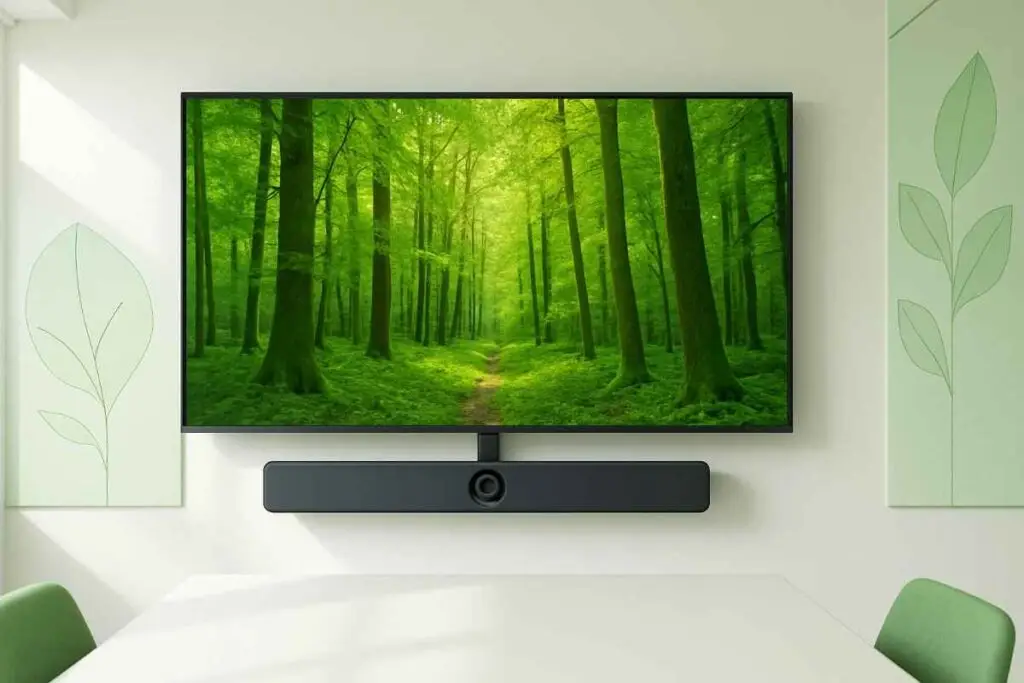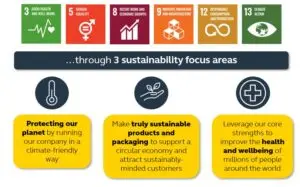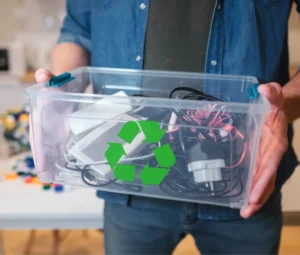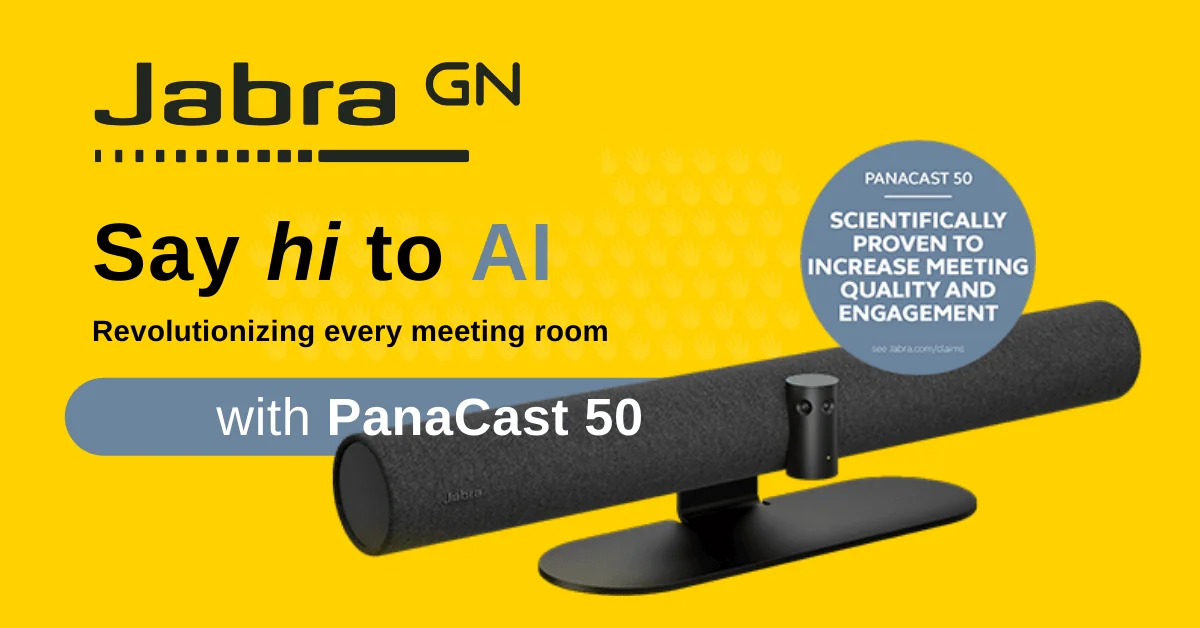Powering a Greener Future: How Audiovisual Solutions Drive Sustainability
Modern Audiovisual (AV) technology is rapidly evolving beyond just enhancing communication and collaboration; it’s increasingly becoming a key player in corporate sustainability strategies. This shift is driven by innovations across the product lifecycle, from design and manufacturing to operation and end-of-life management. Let’s explore the primary ways AV solutions are contributing to a greener future.

Role of Modern AV Solution in Improving Energy Efficiency
Traditional AV setups and conference rooms were major energy consumers. Over time, with the increasing need for better energy-efficient AV systems, the industry evolved substantially.
Energy Efficient Components
- LED displays and projectors are less energy-consuming compared to older display technologies.
- Device processors are also being optimized to consume less power without compromising on performance.
Smart Features
- Intelligent power management systems like automatic power-down and standby modes help reduce energy wastage during idle periods.
- Presence detection sensors power up when a person enters a room and automatically power down when the room is empty.
- Adaptive brightness control systems adjust the device illumination based on the ambient light levels, maintaining optimal visibility.
- AI (Artificial Intelligence) powered AV devices help optimize power consumption dynamically by learning patterns, ensuring that power is used only when required.
“From a sustainability perspective, further savings are achieved in the project: Based on the assumption that the kW-hour of electricity leads to emissions of 0.5 kg CO2 on average, the avoidance of electricity consumption through night-time shutdowns results in a significant reduction in CO2 emissions”
— Sustainable Operation of Media Technology Systems in Meeting Rooms (GUDE Systems, 2021)

Sustainable AV Devices: Materials, Manufacturing, and Lifecycle
Sustainability in AV extends far beyond operational energy use. The materials used, the manufacturing processes, and the overall product lifespan are critical considerations.
Sustainable Materials
As people are becoming more and more environmentally cautious, recycled and eco-friendly materials are in high demand. AV hardware manufacturers are increasingly incorporating post-consumer-recycled (PCR) plastics and metals into AV product castings, components, and even packaging. Instead of increasing the cyber waste load, this effort reduces the reliance on virgin resources and promotes a circular economy.
Eco-friendly Manufacturing
Responsible manufacturing focuses on choosing the right raw materials, reduced or zero use of hazardous substances, and greener production techniques. The production technique is optimized to consume less energy and water, and generate reduced waste.
Increased Product Durability
Sustainable AV systems with a longer lifespan is one of the core focuses for AV manufacturers. Durable AV equipment is built to last longer and is augmented with regular software updates to enhance its features and address security concerns over time. Modular AV designs are also gaining popularity as they can be easily repaired by replacing specific components, thus reducing e-waste.

Handling E-Waste The Right Way
Electronic waste (e-waste) is accumulating at an alarming rate and the AV industry is on its heels to address the issue proactively.
 With the steep advancement in technology, older equipment is converted to e-waste and manufacturers are planning strategies to better manage the disposal of end-of-life products.
With the steep advancement in technology, older equipment is converted to e-waste and manufacturers are planning strategies to better manage the disposal of end-of-life products.
Active take-back programs and certified e-waste recyclers help in responsible disposal of old devices. The devices are safely dismantled and useful materials like metals, plastics, and others are reused in new products. Additionally, manufacturers are also into creating AV devices that can be easily disassembled, thus simplifying the recycling process.
Smarter Spaces For Greener Operations
Sustainability also involves optimizing how AV systems are integrated and managed within a space.
Wireless Solutions
Even though wireless technology devices like Barco Clickshare and Yealink WPP 30 are more about convenient technology, they also offer sustainability benefits. These help avoid the need for extensive cabling, thus reducing the consumption of materials like copper and plastic. Simplified installation and meeting room setup help reduce energy consumption and complex wiring.
Reduced Daily Travel for Work
Hybrid and remote workforces help reduce daily commuting, thus lowering energy consumption. Post the COVID pandemic, the UAE government has extensively promoted the flexible work culture and stated that remote work will help reduce traffic congestion and curb environmental pollution. (Read more)
Remote Maintenance & Support
Prominent AV manufacturers like Jabra and Logitech allow for remote diagnostics, monitoring, and management. This helps avoid the need for technicians to travel on-site for minor updates and troubleshooting. With remote work and remote device inspections, modern AV solutions have helped reduce transportation-related carbon emissions.
Integration with Green Buildings
With the recent advancements in AV technology, systems can be easily integrated with broader building management systems. By facilitating coordinated control, AV equipment can be aligned with smart lighting, HVAC systems, and occupancy sensors to optimize overall building energy efficiency.
By embracing these multifaceted approaches – from energy-sipping components and smart controls to responsible materials, extended lifecycles, effective recycling, and smarter integration – the AV industry is demonstrating a strong commitment to driving sustainability.
Leading by Example: AV Brands Championing Sustainability
With the increasing incorporation of greener practices, AV manufacturers are actively embedding sustainability into their product development cycles. There is a heartfelt commitment to reduce environmental impact and to promote responsible business operations.
Zeal Global joins hands with these sustainability champions to deliver the best AV solutions in Dubai. By collaborating with these forward-thinking AV manufacturers like Jabra, Logitech, Yealink, and Barco, Zeal Global ensures that businesses and professionals in the UAE get to implement meeting room and audio visual systems that align with global sustainability.
Here is a quick look into the sustainability measures undertaken by some prominent AV solution brands.
Jabra: E-Waste Management & Community Impact
The core focus of Jabra’s sustainability measures lies in responsible e-waste management through recycling strategies. They also add extra effort to support community and charitable causes, thus promoting broader environmental awareness.
(Jabra Sustainability Page)
Jabra takes sustainability seriously, conducting detailed Life Cycle Assessments (LCAs) to measure the carbon footprint of their products—from materials like plastics and metals to transportation and usage. These insights help the company both optimize its internal decarbonization strategies and transparently demonstrate its environmental impact to stakeholders.
Maurits Hekking – Global Head of Sustainability at GN Group

- E-Waste Recycling: Jabra actively promotes the recycling of old headsets and electronic devices to prevent improper disposal and pollution.
- Sustainable Design: Lifecycle assessments help analyze the environmental footprint of the production process to improve the process and minimize the environmental impact.
- Sustainable Raw Materials: Jabra advocates the use of recycled, bio-based, and low-polluting alternatives instead of plastics and metals that add to the e-waste. Jabra Speak series speakerphones are made from sustainable materials.
- Sustainable Packaging: The brand aims to have a 100% FSC-certified packaging process. By phasing out virgin plastic and using FSC paper, smaller leaflets, and felt pouches, Jabra has reduced carbon emissions by 84%.
- Decarbonization: Product-level carbon footprint is tracked to implement science-based emission reduction. Jabra aims to achieve net-zero emissions by 2050.
Explore TCO certified Jabra products.
Barco: Integrating Sustainability Across the Value Chain
Barco follows their custom-formulated “Sustainable Impact Journey” strategy, implementing eco-friendly measures from manufacturing to operations and end-of-life management. The program focuses on protecting the earth, engaging people, and empowering society.
If I look back on the past year, I’m especially proud about the substantial increase in revenue from products with the Barco ECO Label, i.e. products that perform exceptionally well according to our ecoscoring methodology. This is the result of hard work of our R&D and product teams. Also, the methodology, which scores products throughout their lifecycle, is unique in our industry.
Dries Vanneste – Group Sustainability Manager @ Barco

- Eco-Design Principles: All Barco products, primarily Barco Clickshare, implement sustainable lifecycle management and Ecoscoring methodology for improved product longevity, repairability, and recyclability.
- Decarbonizing: Following a Science-Based Targets initiative, Barco focuses on reducing Scope 1, 2, and 3 Greenhouse Gas emissions.
- Circular Economy for Waste Reduction: Actively works on circular economy principles, aiming to reduce waste throughout the value chain and improve material efficiency.
- Certifications: Certified with ISO 14001 (Environmental Management) and ISO 14064 (Greenhouse Gas Verification).
Logitech: Designing for a Positive Environmental Future
Logitech actively pursues ambitious goals related to climate action, circularity, and responsible manufacturing, focusing on reducing its carbon footprint and using sustainable materials through its “Design for Sustainability” approach.“We aspire to design each new generation of products with a lower carbon footprint than the previous one and are seeing success.”
– Hanneke Faber, CEO Logitech

- Recycled Materials: PCR and other sustainable materials are increasingly used in the manufacturing process.
- Climate Action Goals: Logitech targets strict measures for substantial carbon emission reduction by 2030 and expands carbon neutral processes across all operations.
- Renewable Electricity: Powers manufacturing processes and factory operations with renewable energy sources.
- Packaging: Adopts eco-friendly packaging design and materials to reduce material usage and promote sustainability.
- Recycling: E-waste, including used Logitech devices, is recycled through local recycling centers to reduce landfill waste and conserve resources.
Yealink: Designing For A Positive Environmental Future
Yealink strategically integrates Environmental, Social, and Governance (ESG) principles, prioritizing the development of green, low-carbon products and optimizing its operations for minimal environmental impact.
(Learn more)
“At Yealink, we are passionately committed to Environmental, Social, and Governance (ESG) principles. We believe true leadership is defined by our contributions to a sustainable and equitable future.
Yealink is not just advancing technology; we are paving the way for a better world.”– David Chen, Chairman of Yealink

- Eco-friendly Product Development: Constant R&D for improving energy-saving, low-carbon products. Yealink also implements green packaging instead of disposable cartons to reduce waste.
- Supplier Level Recycling: Promotes recycling practices at the supplier level to extend environmental responsibility across the supply chain.
- Integrated Building Management System: Aids in automated energy management for improved energy efficiency.
- Environmental Certifications: Yealink holds ISO 14001 and ISO 14064, and complies with environmental regulations like WEEE.
Conclusion: Embracing Sustainable AV for a Better Tomorrow
The journey toward sustainability is a team effort, and today’s AV solution in Dubai is leading the way. Modern audiovisual systems now focus on sustainability through energy-efficient designs, eco-friendly materials, and smart features that support remote work UAE environments. Leading AV brands like Jabra, Barco, Logitech, and Yealink are making real progress toward zero carbon emissions with innovations like low-power components, recycled materials, and comprehensive recycling programs that benefit both the planet and business bottom lines.
By choosing green AV technology, companies in Dubai are building a more sustainable future while enjoying practical benefits like lower energy bills and longer-lasting equipment. The evolution of audiovisual systems is no longer just about better picture and sound—it’s about creating a more responsible world for everyone.



